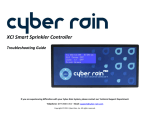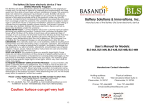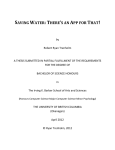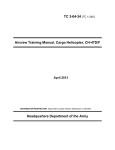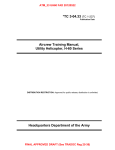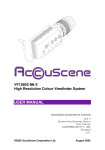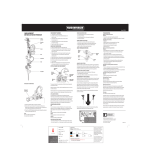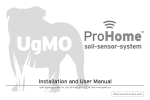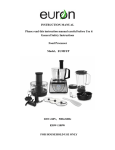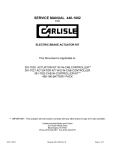Download her new E-Book - Watershed Wise Landscape Program
Transcript
How to Prevent Run-off: An eBook from Water Wise Now http://WaterWiseNow.com/RunOff What is run-off? Run-off is potable water that is wasted due to poor irrigation practices. This water is wasted by hitting our sidewalks, driveways and streets while our sprinklers are watering our yards. It is also created by watering when it’s windy out and watering with too much pressure in your system. Irrigation run-off is nearly ubiquitous in landscaped areas, and contributes to a huge waste of water everywhere in California. You are not alone. Many homeowners are worried that they don’t have the money or time to make their irrigation systems meet these new mandatory restrictions. Water Wise Now is here to help. With just a few minor changes, you can eliminate sprinkler run-off problems. In this eBook you’ll learn: RUN-OFF PUBLIC ENEMY #1 Low Head Drainage What it is and how to stop it RUN-OFF PUBLIC ENEMY #2 Inefficient Sprinkler Nozzles How to upgrade your sprinklers to reduce runoff RUN-OFF PUBLIC ENEMY #3 Watering too Fast How to reduce run-off by changing your watering schedule Stuck or confused? Ask us! Call toll-free at 1(844) LESS-H2O or email [email protected] Copyright 2014 © Water Wise Now, LLC. All Rights Reserved. How to Prevent Run-off eBook http://WaterWiseNow.com/RunOff Run-off Public Enemy #1 Low Head Drainage What is Low Head Drainage? When watering any area with an elevation change (even as little as one foot), all of the leftover water in your underground pipes drains out through the lowest sprinkler head(s) on the line—every time you water. Sometimes this water looks like a sheet coming down from the lawn, but sometimes it takes looking closely because the water comes out of the lowest head(s) slowly. Either way, the waste is the same. All of that water is going right down the drain. How to Stop Low Head Drainage There are special sprinkler bodies you can buy that prevent water from flooding out of the sprinkler when the system turns off. These sprinklers have a small device installed in them called a check-valve. Stopping low head drainage is as simple replacing the sprinklers at the lowest part of each sprinkler station (valve) in your system. Stuck or confused? Ask us! Call toll-free at 1(844) LESS-H2O or email [email protected] Copyright 2014 © Water Wise Now, LLC. All Rights Reserved. PAGE 2 How to Prevent Run-off eBook http://WaterWiseNow.com/RunOff Run-off Public Enemy #1 Low Head Drainage Meet SAM. Examples of situations that need SAM’s help! In some cases, only one sprinkler is located at the lowest elevation, usually at the corner of a sidewalk, driveway or at the street. Like the situation there on the left. SAM stands for seal-a-matic—and it stops runoff when sprinklers are at different elevations. This is an issue anywhere on a property where there are sprinklers at the bottom of hills, and even on gentle slopes. Made by America’s most trusted irrigation manufacturer—Rain Bird—you won’t find SAM sprinklers at your local big-box store because they are only distributed to via wholesale irrigation suppliers. We sell them directly to homeowners like you because SAM stops this common type of runoff in the landscape and everyone should have access to tools that help us save water. Many times the bottom of a planting area has more than one sprinkler at the same low elevation, next to a sidewalk or at the street. This homeowner has more than one sprinkler needing SAM’s help! The property owner for this landscaped hillside has installed SAM sprinklers all along the bottom of their slope, and now they don’t create any run-off! Stuck or confused? Ask us! Call toll-free at 1(844) LESS-H2O or email [email protected] Copyright 2014 © Water Wise Now, LLC. All Rights Reserved. PAGE 3 How to Prevent Run-off eBook http://WaterWiseNow.com/RunOff Run-off Public Enemy #1 Low Head Drainage Great! How do I put to SAM work at my house? With our help, you will replace the lowest sprinkler(s) on the line for each station (valve) where sprinklers are at different elevations— they cost $3-12 each, depending on the size of the sprinkler you’re replacing. Download and print our free Run-off Inspection Worksheet to help you keep track of important information as you go. http://WaterWiseNow.com/RunOffWorksheet Before you get started, be sure to read through the whole worksheet. There is a list of equipment you’ll need, some prerequisite concepts for you to know, and some instructions on how to identify and resolve overspray which you might encounter while you’re inspecting your system for low head drainage. When you’re done filling out the worksheet and evaluating run-off issues at your house, go online and order the SAM sprinklers you need. Then, turn to Page 5 where we’ll teach you how to install them! How to Install SAM Sprinklers Once SAM comes to the rescue (the replacement sprinklers are delivered): For each Rain Bird sprinkler you’re replacing 1. Unscrew the cap, remove it and take everything out (inside there is a spring and a riser..we call this the “guts”). 2. Replace “the guts” with the new SAM cap and it’s guts. You can then take the parts you removed from your existing sprinkler body, put them into the empty SAM body, and make a new sprinkler that can be used elsewhere! For each non Rain Bird sprinkler you’re replacing You’ll dig up and unscrew the entire sprinkler body and then screw in the entire SAM sprinkler body. For all sprinklers you’re replacing Take the small sprinkler nozzle (where the water comes out) off the old sprinkler, and screw it into the SAM sprinkler. At this point, you may want consider replacing Stuck or confused? Ask us! Call toll-free at 1(844) LESS-H2O or email [email protected] Copyright 2014 © Water Wise Now, LLC. All Rights Reserved. PAGE 4 How to Prevent Run-off eBook http://WaterWiseNow.com/RunOff Run-off Public Enemy #1 Low Head Drainage the old nozzle all together and replace it with a Hunter MP Rotator. See Public Enemy #2: Inefficient Sprinkler Nozzles on Page 6. Professional Tip for Replacing Sprinkler Bodies! HOW TO DIG UP AND REPLACE A SPRINKLER BODY THE RIGHT WAY 1. Remove the sprinkler flag. 2. The goal is to take the sod, roots and dirt out in one piece. If the sprinkler you’re replacing is surrounded by lawn, we recommend this method of digging up the grass and soil so repairs look nice and the grass stays healthy. Equipment You’ll Need Digging Shovel with pointed center Hand trowel Pliers that can open as wide as 2-1/2 inches Tarp or plastic trash bag With your digging shovel, angling the tip of the shover towards the sprinkler, put the tip on the ground about 10 inches from your sprinkler head and push it down as deep as possible. Don’t worry if it comes out in a couple of pieces, you just want it to be in large chunks. Place the grass chunks on top of the lawn next to where you are working. Stuck or confused? Ask us! Call toll-free at 1(844) LESS-H2O or email [email protected] Copyright 2014 © Water Wise Now, LLC. All Rights Reserved. PAGE 5 How to Prevent Run-off eBook http://WaterWiseNow.com/RunOff Run-off Public Enemy #1 Low Head Drainage Note: If you have difficulty unscrewing the sprinkler, use the pliers to grasp the sprinkler body to help you turn it. 6. Remove the sprinkler nozzle and filter from the old spray body, by unscrewing them from the sprinkler cap. You’ll need them for the new one. 7. Install the new sprinkler. Screw it in to the same place the old one was attached. 3. With your hand trowel (or shovel if you prefer), remove the dirt around the sprinkler. Place the loose dirt on top of the tarp or plastic trash bag. This prevents the soil from vanishing into the lawn. You will use this soil to refill the hole after you are finished. Expose the entire sprinkler until you see the connection at the bottom. Sprinklers are always screwed into a water supply pipe of some kind (like PVC or black flexible pipe). 5. Unscrew the sprinkler. Do not be alarmed if water starts coming out of the pipe! This is just left over water in the pipes from when you turned them on and will stop eventually. 8. Notice the height of the new sprinkler, and make sure it will not be buried at a deeper depth than the bottom of your grass blades. You want it to be positioned at the top of the soil level. 9. Take the soil you placed on the tarp, and begin filling up the hole. Compress the soil around the new sprinkler so it stays in place, and so the grass stays at the proper level. 10. Replace the grass clumps on top of the soil around the new sprinkler. If the pieces are too big and you have trouble making them fit properly, it is ok to break them up into smaller pieces. 11. Before you install your new nozzle, flush the system. To do this, go to the controller and manually turn on the station you’re working on. Stuck or confused? Ask us! Call toll-free at 1(844) LESS-H2O or email [email protected] Copyright 2014 © Water Wise Now, LLC. All Rights Reserved. PAGE 6 How to Prevent Run-off eBook http://WaterWiseNow.com/RunOff Run-off Public Enemy #1 Low Head Drainage The new sprinkler body comes with an orange cap at the top. Keep this orange cap in place when you first turn on the water. A large amount of water will come out of the orange cap, but this is good because it is flushing out any dirt that may have gotten in the line. 12. Turn the water off and replace your old nozzle into the new sprinkler body. Now, on the new spray body, pull the tab on the orange cap, this pulls up the sprinkler riser. HOLD THE RISER FIRMLY WITH YOUR OTHER HAND WHILE YOU UNSCREW THE ORANGE CAP AND REPLACE IT WITH THE OLD NOZZLE! Look closely to see the orientation of the new nozzle so you can position it to spray the corrrect direction. Don’t worry, you can adjust this when the water is on, too. Note: If the riser falls into the sprinkler body before you put the nozzle on, don’t worry. Unscrew the whole sprinkler cap, and take everything out of the body. You will see that the cap can slide down around the riser, and you can expose the threaded top of the riser and screw on the nozzle. Then put it all back. 12. Go back to the controller and turn on the water. Take your pliers and GENTLY grab the riser and turn it so the water sprays in the direction you want. If you are wearing gloves, you can also grab the riser and turn it with your hand. It will make a grinding sound when it turns. You have now successfully dug up and replaced a sprinkler!! Time to party!! Stuck or confused? Ask us! Call toll-free at 1(844) LESS-H2O or email [email protected] Copyright 2014 © Water Wise Now, LLC. All Rights Reserved. PAGE 7 How to Prevent Run-off eBook http://WaterWiseNow.com/RunOff Run-off Public Enemy #2 Inefficient Sprinkler Nozzles Inefficient sprinkler nozzles apply water too quickly for it to absorb into the soil. It pools up and goes right down to the street instead of nourishing your plants. Download and print our free Hunter MP Rotator Worksheet to help you keep track of important information as you assess your sprinkler system. How to Stop It http://WaterWiseNow.com/MPRotatorWorksheet Before you get started, be sure to read through the whole worksheet. There is a list of equipment you’ll need, some prerequisite concepts for you to know, and some instructions on how to order Hunter MP Rotators. By switching out your conventional sprinkler nozzles with newer rotary nozzles like Hunter MP Rotators, you can slow your water application rate by 75% and save 30% of water that would have been lost to run-off. You’ll need to water for longer periods of time, but you’ll use much less water. When you’re done filling out the worksheet and planning your sprinkler nozzle upgrade, go online and order the Hunter MP Rotators you need. http://WaterWiseNow.com/MPRotators The best installation instructions we’ve seen are in this video: http://youtu.be/yWOzlEbbYJM?t= 47s Replacing sprinkler nozzles is easy. It’s just a matter of unscrewing the existing nozzle and replacing it with the new one. After the new nozzles are in place, you’ll turn on your irrigation system and manually adjust the radius and spray arc for each one with a free, easy-to-use tool we’ll send along with your order. Stuck or confused? Ask us! Call toll-free at 1(844) LESS-H2O or email [email protected] Copyright 2014 © Water Wise Now, LLC. All Rights Reserved. PAGE 8 How to Prevent Run-off eBook http://WaterWiseNow.com/RunOff Run-off Public Enemy #3 Watering Too Fast Run-off is usually caused by overwatering. How to Stop Watering Too Fast Sometimes we think we’re watering the right amount, but we’re still creating run-off. Modify your watering schedule to employ the Cycle-Soak method. This often happens because of special conditions where we’re watering that prevent all of the water we’re using from getting absorbed into the soil. The Cycle-Soak method breaks up single, longer watering periods into several smaller periods, spaced out to allow water to absorb into the soil before you apply more. By allowing the water to infiltrate into the soil at the appropriate rate, you minimize runoff. COMMON SITUATIONS THAT REQUIRE SPECIAL WATERING SCHEDULES Clay soils have what is known as a slow infiltration rate. These soils let water in much more slowly than loam or sandy soils. Compacted lawns also have a slow infiltration rate because there are very few spaces between the grass for the water to find it’s way to the soil. Slopes (often these are hills, but any land where one side is higher than the other, even just a little, is considered a slope) have gravity interfering with water infiltration—gravity acts on the water, pulling it down the slope before it has a chance to reach the soil. For example, if you currently water your front lawn for 6 minutes once per watering day, you would change your irrigation controller to water 3 times per watering day for 2 minutes each time, leaving a minimum of 30 minutes in between each watering. ABOUT YOUR CONTROLLER There are three different types of controllers when considering Cycle-Soak: A fancy-pants Smart Controller that has a Cycle-Soak button or method already in it. All you need to do is activate it. This is the easiest way to do Cycle-Soak. Check your Owner’s Manual for instructions on how to set this up. Stuck or confused? Ask us! Call toll-free at 1(844) LESS-H2O or email [email protected] Copyright 2014 © Water Wise Now, LLC. All Rights Reserved. PAGE 9 How to Prevent Run-off eBook http://WaterWiseNow.com/RunOff Run-off Public Enemy #3 Watering Too Fast A good-quality controller that has multiple start times, allowing you to set up multiple watering cycles per day. This may require a little patience and getting to know your controller better, but it’s fairly easy to set this up. Consult your Owner’s Manual for instructions on how to do this. Mechanical controllers and barebones automatic controllers that don’t have multiple start times as a feature. You’re kind of out of luck with these controllers, but if you’ve got a little spare cash, we highly recommend taking this as an opportunity to upgrade your irrigation timer to a Smart Controller. The great news is, most water districts are offering a substantial rebate on purchases of Smart Controllers—some even give them away for free and install and program them for free! If you’re buying your own, our Top Pick for Smart Controller is the Rain Bird ESPSMTe (we know, that needs a better name). The ESP stands for Extra Simple Programming, and has been the Rain Bird standard controller interface for a long time. It is indeed, very simple to use. The ESP-SMTe not only includes weather-based data in deciding your irrigation schedule, it takes into account your yard’s micro-climates (shady and sunny spots), your soil type, and the type of plants being watered. After a few months of tinkering with it, you’ll find you’ll almost never need to worry about whether you’re watering too much again. Download and print our free Cycle-Soak Timing Worksheet to help you assess how you’ll modify your watering schedule. http://WaterWiseNow.com/CycleSoakWorksheet Before you get started, be sure to read through the whole worksheet. There is a list of equipment you’ll need and some prerequisite concepts for you to know. When you’re done, come back here and learn how to reprogram your controller to use CycleSoak Watering. Stuck or confused? Ask us! Call toll-free at 1(844) LESS-H2O or email [email protected] Copyright 2014 © Water Wise Now, LLC. All Rights Reserved. PAGE 10 How to Prevent Run-off eBook http://WaterWiseNow.com/RunOff Run-off Public Enemy #3 Watering Too Fast How to Properly Set Up a “Cycle and Soak” Watering Schedule Now that you know how long it takes for the run off to occur and why, you can re-program your clock to a cycle and soak schedule. GO DOWNLOAD YOUR CONTROLLER’S USER MANUAL IF YOU HAVEN’T ALREADY Minutes: Now comes the fun part! Scheduling the minutes. The stations are numbered and hopefully you made note of your stations and what they’re watering in the Cycle Soak Timing Worksheet. In the worksheet you determined stations that have run off, so you already know how long to set the timer! Days to Water: First, you need to check with your local water agency to see what days they allow you to water. For example, on station one it took 3 minutes for your run-off to occur, but you usually water your grass 8 minutes. You will set the first start time at 2:00am for your sprinklers with station one at 3 minutes. On the controller, there is a place to enter the desired watering days. Look for a Days to Water button or dial feature, or check with the manual for your particular controller. Add up how many minutes it will take for the whole system to water. This is your total system run time. Let’s say it’s 15 minutes for this example. Start Time: It’s best to water early in the morning. In the summer, you can water as early as 2:00am (if it doesn’t wake you up). In the winter, 6:00am is best. Look for a Start Times button or dial feature, or check with the manual for your particular controller. Then schedule the second Start Time to be the first start time + total system run time. 2:00am + 15 minutes = 2:15am. This would be the second start time. Again, program a run time of 3 minutes for station one. If you have a newer controller, or a Smart Controller, see the manual. The controller will configure Cycle-Soak for you! Notice how we just cut off the last 2 minutes? Most of us overwater, and now that you are using a more efficient program, your plants won’t miss that extra 2 minutes of water! Stuck or confused? Ask us! Call toll-free at 1(844) LESS-H2O or email [email protected] Copyright 2014 © Water Wise Now, LLC. All Rights Reserved. PAGE 11











